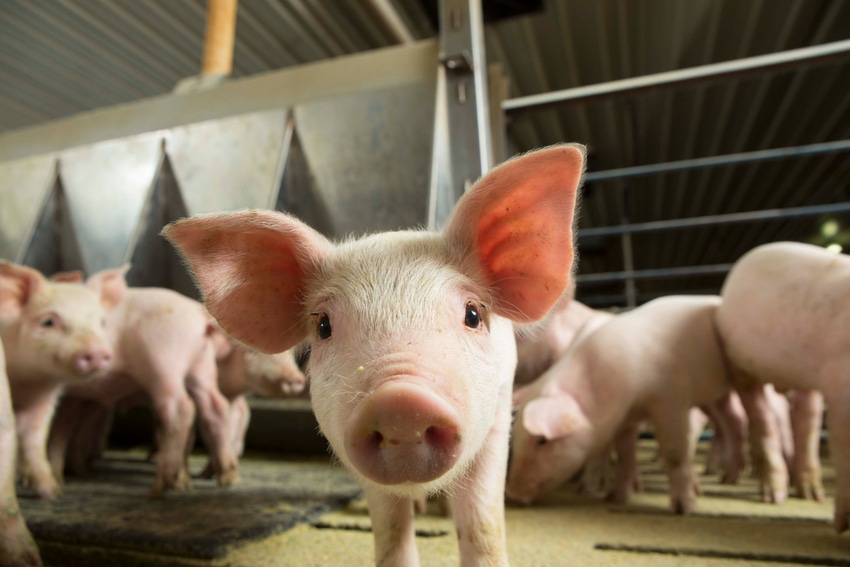Feeder pig movements played a more critical role in shaping patterns of spatial spread of PRRSV L1A.
September 14, 2021

Although the critical role of pig movements in the spatial spread of porcine reproductive and respiratory syndrome virus (PRRSV) has been reported previously [1]–[5], understanding the relative contribution of different types of pig movements to the spread and evolution of PRRSV can help us focus disease management efforts during outbreaks. Using viral sequence data, we can trace patterns of spatial spread of PRRSV and analyze how potential drivers of pathogen spread, such as different types of animal movement, shape patterns of the regional spread of the virus.
Here, we applied evolutionary models to explain the geographical spread and evolution of a rapidly spreading strain of PRRSV-type 2 (sub-lineage L1A), which predominantly correlates to the RFLP type 1-7-4. This sublineage emerged in ~2014 and has comprised ~60% of detected PRRSV sequences in the U.S. ever since. In the model, we combined ORF5 PRRSV sequences collected from farms in a swine dense production region in the U.S. between 2014 and 2017 with animal movement data, spatial, and environmental data. We grouped animal movement data by age-group of animals moved: weaned pig movements (3-4 weeks), feeder movements (8-25 weeks), and breeding movements (≥21 weeks). The study region was then divided into 13 geographic sectors, and movement data were summarized across all farms within each sector.
We observed that the between-sector spread of L1A was positively associated with three main factors: movement of feeder pigs, the spatial adjacency of sectors, and farm density. Compared to movements of weaned and breeding pigs, transportation of feeder pigs was much more strongly associated with higher viral dispersal rates between sectors. This suggests that nurseries may be acting as amplifiers for viral population, perhaps related to waning maternal antibodies and mixing of weaned pigs from multiple sources. Also, unlike breeding farms, biosecurity measures in nurseries (or trucks originating from them) tend to be more relaxed, which may influence the risk of onward transmission of the virus. Production systems should consider stricter biosecurity measures in nurseries and better truck hygiene to mitigate the risk of disease spread from nurseries.
Higher rates of between-sector viral dispersal were also documented between adjacent sectors, highlighting the importance of the spatial structure of host populations in shaping the distribution of disease. L1A spread amongst adjacent sectors could have been through mechanical spread-especially in areas with shared service providers and infrastructure. As such, for effective disease management, biosecurity threats in adjacent sectors should be considered when designing intervention measures in nearby regions. High farm density has been associated with PRRS spread and maintenance [6]–[9]. Hence our findings, while unsurprising, underscore the risk associated with high farm density.
In summary, feeder pig movements played a more critical role in shaping patterns of spatial spread of PRRSV L1A, more so than other types of movements. More research is needed to elucidate why these movements from nurseries may be riskier, but the ability to better identify crucial routes of disease spread is invaluable for making informed decisions for targeting and optimizing intervention measures. Taken together, these results suggest that PRRS dynamics and transport of growing pigs may contribute disproportionately to the regional spread and long-term persistence of PRRS.
This work is published here.
Sources: , who is solely responsible for the information provided, and wholly own the information. Informa Business Media and all its subsidiaries are not responsible for any of the content contained in this information asset.
References
D. N. Makau, I. A. D. Paploski, C. A. Corzo, and K. VanderWaal, “Dynamic network connectivity influences the spread of a sub‐lineage of porcine reproductive and respiratory syndrome virus,” Transbound. Emerg. Dis., vol. 00, pp. 1–14, Feb. 2021.
M. Ramírez et al., “Detection of porcine reproductive and respiratory syndrome virus ( PRRSV) 1‐7‐4‐type strains in Peru,” Transbound. Emerg. Dis., vol. 66, no. 3, pp. 1107–1113, May 2019.
J. Schulz, A. Boklund, T. H. B. Halasa, N. Toft, and H. H. K. Lentz, “Network analysis of pig movements: Loyalty patterns and contact chains of different holding types in Denmark,” PLoS One, vol. 12, no. 6, pp. 1–19, 2017.
G. S. Silva, G. Machado, K. L. Baker, D. J. Holtkamp, and D. C. L. Linhares, “Machine-learning algorithms to identify key biosecurity practices and factors associated with breeding herds reporting PRRS outbreak,” Prev. Vet. Med., vol. 171, no. April, p. 104749, Nov. 2019.
K. VanderWaal, I. A. D. Paploski, D. N. Makau, and C. A. Corzo, “Contrasting animal movement and spatial connectivity networks in shaping transmission pathways of a genetically diverse virus,” Prev. Vet. Med., vol. 178, no. March, p. 104977, May 2020.
M. A. Alkhamis, A. G. Arruda, R. B. Morrison, and A. M. Perez, “Novel approaches for Spatial and Molecular Surveillance of Porcine Reproductive and Respiratory Syndrome Virus (PRRSv) in the United States,” Sci. Rep., vol. 7, no. 1, p. 4343, Dec. 2017.
M. A. Alkhamis, A. G. Arruda, C. Vilalta, R. B. Morrison, and A. M. Perez, “Surveillance of porcine reproductive and respiratory syndrome virus in the United States using risk mapping and species distribution modeling,” Prev. Vet. Med., vol. 150, no. January 2017, pp. 135–142, 2018.
A. G. Arruda, C. Vilalta, A. Perez, and R. Morrison, “Land altitude, slope, and coverage as risk factors for Porcine Reproductive and Respiratory Syndrome (PRRS) outbreaks in the United States,” PLoS One, vol. 12, no. 4, pp. 1–14, 2017.
L. D. Firkins and R. M. Weigel, “A retrospective study of risk factors for porcine reproductive and respiratory syndrome virus infection and clinical disease in swine herds in Illinois during the early years of the pandemic,” J. Swine Heal. Prod., vol. 12, no. 1, pp. 23–28, 2004.
You May Also Like



